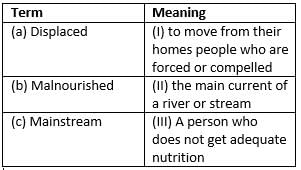Important Questions Test: Understanding Marginalisation - UPSC MCQ
15 Questions MCQ Test Polity and Constitution (Prelims) by IAS Masters - Important Questions Test: Understanding Marginalisation
Constitution provides safeguards to religious and linguistic _______ as part of our Fundamental Rights.
The term minority is most commonly used to refer to
Every citizen of India can approach the courts if they believe that their
Chaired by Justice______, the committee examined the social, economic and educational status of the Muslim community in India.
Muslims may wear a ____, sport a long beard, wear a__, and these become ways to identify all Muslims.
The caste system is a hierarchical system and Dalits are considered to be
___ women are an important part of the women's movement in India.
Adivasis are invariably portrayed in very stereotypical ways in following except
Many of India's most important mining and industrial centers are located in Adivasi areas?
Read the below mention song
Come Mini, let's go to Assam
Our country has so much suffering
The country of Assam, oh Mini
Has tea garden full of greenery...
The Sardar says work, work
The Babu says catch and bring them in
The Saheb says I'll take off the skin of your back
Hey Jaduram, you deceived us by sending us to Assam
The above song capture
Economic, ____ and political factors work together to make certain groups in society feel marginalized
Safeguards are needed to protect ___ communities against the possibility of being culturally dominated by the ___
A _____ is a part of a city in which members of a minority group live, especially because of social, legal, or economic pressure
|
36 videos|144 docs|138 tests
|
|
36 videos|144 docs|138 tests
|



















